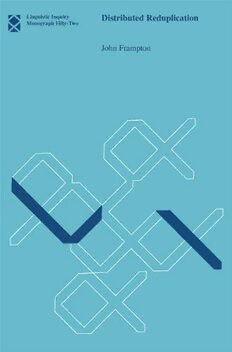
Distributed Reduplication (Linguistic Inquiry Monographs) PDF
245 Pages·2009·0.887 MB·English
Most books are stored in the elastic cloud where traffic is expensive. For this reason, we have a limit on daily download.
Preview Distributed Reduplication (Linguistic Inquiry Monographs)
Description:
A convincing account of reduplicative phenomena has been a longstanding problem for rule-based theories of morphophonology. Many scholars believe that derivational phonology is incapable in principle of analyzing reduplication. In Distributed Reduplication, John Frampton demonstrates the adequacy of rule-based theories by providing a general account within that framework and illustrating his proposal with extensive examples of widely varying reduplicatation schemes from many languages. His analysis is based on new proposals about the structure of autosegmental representations. Although Frampton offers many new ideas about the computations that are put to use in reduplicative phonology, some fairly radical, his intent is conservative: to provide evidence that the model of the phonological computation developed by Chomsky and Halle in 1968 is fundamentally correct—that surface forms are produced by the successive modification of underlying forms. Frampton's theory accounts for the surface properties of reduplicative morphemes by operations that are distributed at various points in the morphophonology rather than by a single operation applied at a single point. Lexical insertion, prosodic adjustment, and copying can each make a contribution to the output at different points in the computation of surface form. Frampton discusses particular reduplicative processes in many languages as he develops his general theory. The final chapter provides an extensive sequence of detailed case studies. Appendixes offer additional material on the No Crossing Constraint, the autosegmental structure of reduplicative representations, linearization, and concatenative versus nonconcatenative morphology. This volume will play a major role in the main debate of current phonological research: what is the nature of the phonological computation? Linguistic Inquiry Monograph 52
See more
The list of books you might like
Most books are stored in the elastic cloud where traffic is expensive. For this reason, we have a limit on daily download.
